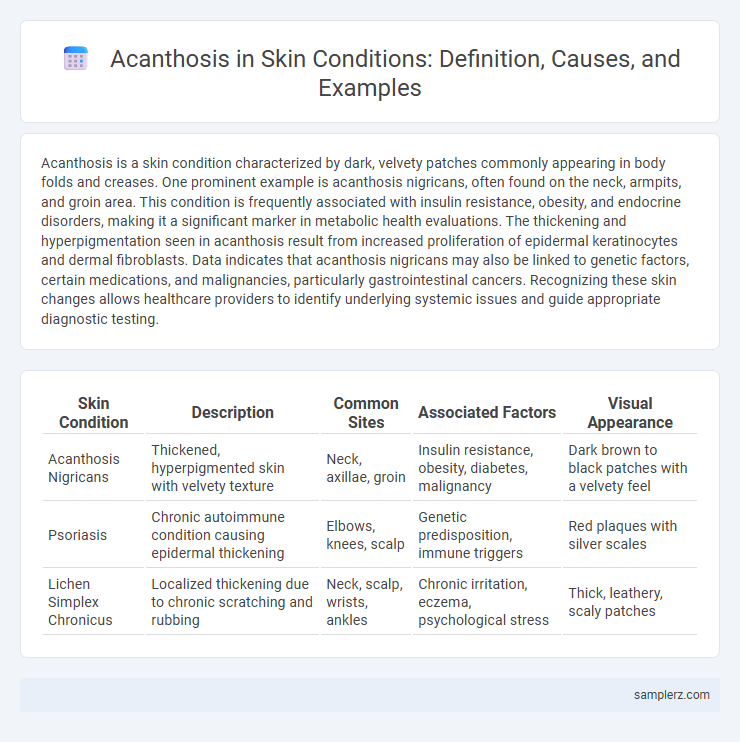Acanthosis is a skin condition characterized by dark, velvety patches commonly appearing in body folds and creases. One prominent example is acanthosis nigricans, often found on the neck, armpits, and groin area. This condition is frequently associated with insulin resistance, obesity, and endocrine disorders, making it a significant marker in metabolic health evaluations. The thickening and hyperpigmentation seen in acanthosis result from increased proliferation of epidermal keratinocytes and dermal fibroblasts. Data indicates that acanthosis nigricans may also be linked to genetic factors, certain medications, and malignancies, particularly gastrointestinal cancers. Recognizing these skin changes allows healthcare providers to identify underlying systemic issues and guide appropriate diagnostic testing.
Table of Comparison
| Skin Condition | Description | Common Sites | Associated Factors | Visual Appearance |
|---|---|---|---|---|
| Acanthosis Nigricans | Thickened, hyperpigmented skin with velvety texture | Neck, axillae, groin | Insulin resistance, obesity, diabetes, malignancy | Dark brown to black patches with a velvety feel |
| Psoriasis | Chronic autoimmune condition causing epidermal thickening | Elbows, knees, scalp | Genetic predisposition, immune triggers | Red plaques with silver scales |
| Lichen Simplex Chronicus | Localized thickening due to chronic scratching and rubbing | Neck, scalp, wrists, ankles | Chronic irritation, eczema, psychological stress | Thick, leathery, scaly patches |
Understanding Acanthosis: Definition and Key Features
Acanthosis is characterized by the thickening of the skin's epidermal layer, often presenting as dark, velvety patches commonly found in body folds such as the neck, armpits, and groin. This condition is frequently associated with insulin resistance, obesity, and endocrine disorders, serving as a clinical marker for underlying metabolic abnormalities. Histologically, acanthosis features hyperplasia of the stratum spinosum, increased melanin deposition, and papillomatosis, which contribute to its distinctive appearance.
Common Skin Conditions Associated with Acanthosis
Acanthosis nigricans is commonly associated with insulin resistance, often seen in individuals with type 2 diabetes or obesity. It presents as hyperpigmented, velvety plaques typically located in intertriginous areas such as the neck, axillae, and groin. Other conditions linked to acanthosis include endocrine disorders like polycystic ovary syndrome (PCOS) and rare malignancies causing paraneoplastic acanthosis nigricans.
Clinical Presentation of Acanthosis in Dermatology
Acanthosis nigricans commonly presents as hyperpigmented, velvety plaques predominantly found in intertriginous areas such as the neck, axillae, and groin. These thickened, darkened patches may be asymptomatic but often serve as markers for underlying insulin resistance or endocrine disorders. Dermatologists frequently observe the progressive texture change alongside elevated skin folds, aiding in differential diagnosis from other dermatoses.
Acanthosis Nigricans: Hallmark Signs and Symptoms
Acanthosis nigricans presents with hallmark signs such as hyperpigmented, velvety plaques typically found in body folds like the neck, armpits, and groin. These thickened, darkened areas of skin often indicate underlying insulin resistance or endocrine disorders. Early recognition of these symptoms is crucial for diagnosing associated metabolic conditions and preventing further complications.
Psoriasis and Acanthosis: How They Interact
Acanthosis, characterized by thickening of the epidermal layer, often appears in chronic skin conditions like psoriasis, where hyperproliferation of keratinocytes leads to plaques and scales. Psoriasis-induced acanthosis results from an inflammatory cascade involving T-cells and cytokines such as IL-17 and TNF-alpha, which amplify epidermal growth and disrupt normal skin turnover. Understanding the interplay between acanthosis and psoriasis aids in targeted therapies like biologics that inhibit inflammatory mediators to reduce epidermal thickening and scaling.
Diagnosis: Identifying Acanthosis in Skin Lesions
Acanthosis is diagnosed by observing thickened, hyperpigmented skin lesions typically found in body folds such as the neck, armpits, and groin. Dermatoscopic examination and skin biopsy can confirm acanthosis by revealing epidermal hyperplasia and increased melanin deposition in the basal layer. Identifying underlying conditions like insulin resistance or malignancies is crucial for comprehensive management of acanthosis.
Histopathological Examples of Acanthosis
Histopathological examples of acanthosis in skin conditions typically show epidermal hyperplasia characterized by thickening of the stratum spinosum with elongated rete ridges. Microscopic examination reveals increased keratinocyte proliferation and mild orthokeratosis or parakeratosis depending on the underlying pathology. Commonly associated disorders include acanthosis nigricans, psoriasis, and chronic eczema, where biopsy confirms acanthotic features.
Acanthosis in Benign vs. Malignant Skin Disorders
Acanthosis commonly presents as hyperpigmented, velvety plaques in benign conditions like acanthosis nigricans, often associated with insulin resistance or obesity. In malignant skin disorders, acanthosis may indicate paraneoplastic syndromes, such as malignant acanthosis nigricans linked to gastrointestinal adenocarcinoma. Differentiating benign from malignant acanthosis requires clinical correlation and histopathological evaluation to guide appropriate management.
Treatment Approaches for Skin Conditions with Acanthosis
Treatment approaches for skin conditions with acanthosis often include topical retinoids and corticosteroids to reduce hyperkeratosis and inflammation. Oral medications like metformin are prescribed particularly when acanthosis nigricans is associated with insulin resistance or diabetes. Laser therapy and lifestyle modifications, including weight loss and improved glycemic control, also contribute to managing the condition effectively.
Preventive Measures and Patient Education on Acanthosis
Acanthosis nigricans often appears as dark, velvety patches on the skin, commonly in body folds such as the neck, armpits, and groin, signaling underlying conditions like insulin resistance or obesity. Preventive measures include maintaining a healthy weight, adopting a balanced diet low in processed sugars, and regular physical activity to improve insulin sensitivity. Patient education focuses on early recognition of skin changes, adherence to lifestyle modifications, and routine monitoring of blood glucose levels to reduce progression and associated metabolic risks.

example of acanthosis in skin condition Infographic
 samplerz.com
samplerz.com